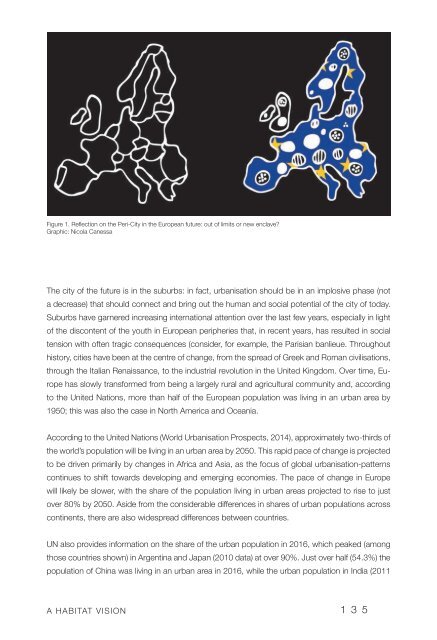Dynamics of Periphery
978-3-86859-511-6 https://www.jovis.de/de/buecher/vorschau/product/dynamics_of_periphery.html
978-3-86859-511-6
https://www.jovis.de/de/buecher/vorschau/product/dynamics_of_periphery.html
Create successful ePaper yourself
Turn your PDF publications into a flip-book with our unique Google optimized e-Paper software.
Figure 1. Reflection on the Peri-City in the European future: out <strong>of</strong> limits or new enclave?<br />
Graphic: Nicola Canessa<br />
The city <strong>of</strong> the future is in the suburbs: in fact, urbanisation should be in an implosive phase (not<br />
a decrease) that should connect and bring out the human and social potential <strong>of</strong> the city <strong>of</strong> today.<br />
Suburbs have garnered increasing international attention over the last few years, especially in light<br />
<strong>of</strong> the discontent <strong>of</strong> the youth in European peripheries that, in recent years, has resulted in social<br />
tension with <strong>of</strong>ten tragic consequences (consider, for example, the Parisian banlieue. Throughout<br />
history, cities have been at the centre <strong>of</strong> change, from the spread <strong>of</strong> Greek and Roman civilisations,<br />
through the Italian Renaissance, to the industrial revolution in the United Kingdom. Over time, Europe<br />
has slowly transformed from being a largely rural and agricultural community and, according<br />
to the United Nations, more than half <strong>of</strong> the European population was living in an urban area by<br />
1950; this was also the case in North America and Oceania.<br />
According to the United Nations (World Urbanisation Prospects, 2014), approximately two-thirds <strong>of</strong><br />
the world’s population will be living in an urban area by 2050. This rapid pace <strong>of</strong> change is projected<br />
to be driven primarily by changes in Africa and Asia, as the focus <strong>of</strong> global urbanisation-patterns<br />
continues to shift towards developing and emerging economies. The pace <strong>of</strong> change in Europe<br />
will likely be slower, with the share <strong>of</strong> the population living in urban areas projected to rise to just<br />
over 80% by 2050. Aside from the considerable differences in shares <strong>of</strong> urban populations across<br />
continents, there are also widespread differences between countries.<br />
UN also provides information on the share <strong>of</strong> the urban population in 2016, which peaked (among<br />
those countries shown) in Argentina and Japan (2010 data) at over 90%. Just over half (54.3%) the<br />
population <strong>of</strong> China was living in an urban area in 2016, while the urban population in India (2011<br />
A HABITAT VISION 135


















